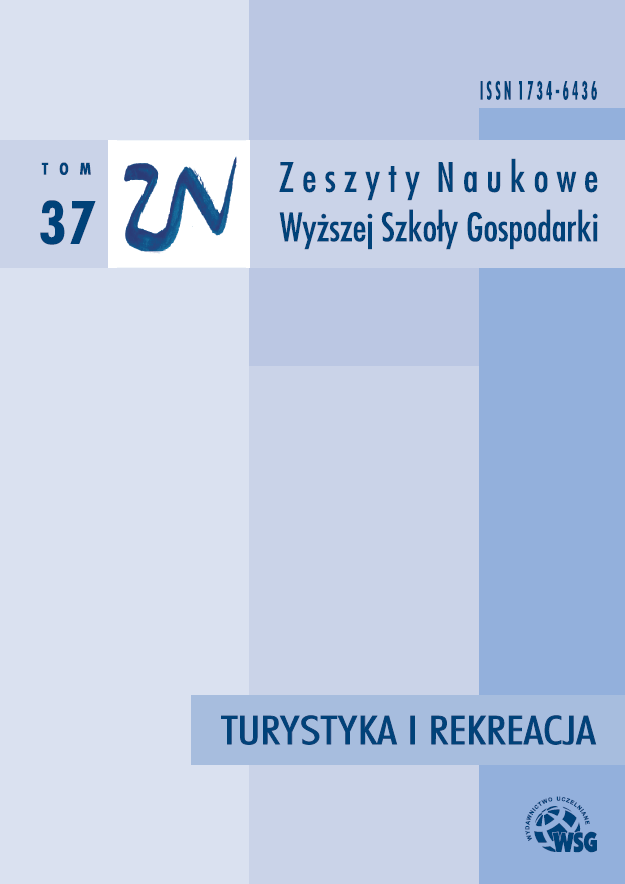Management of sightseeing and tourist values in the Piła region
Keywords:
management, marketing, sightseeing and tourism valuesAbstract
General description of the problem: the problem of research in the field of managing sightseeing and tourism values is rarely undertaken in Polish literature, which results from the management system functioning until 1989 (producer’s market), as well as from the way local government operated at that time.
Purpose of the article: to analyze the sightseeing and tourism values of the Piła region and to present the current problems related to their management.
Research methods: analysis of foreign and Polish literature in tourism management and the quantitative and qualitative method related to the location of the studied values.
The most essential theses: the Piła region has sightseeing and tourist values, there is little infrastructure in the area of sightseeing and tourism in the studied region, however, there are various other forms of activity, the principles of functioning of the tourist attractions offered require changes, in the studied region no research related to sightseeing values is used -tourist and tourist attractions.
Research results: the conducted research has shown that it is necessary to implement more effective methods of managing sightseeing and tourism values in the Piła region and marketing principles, as well as research methods and training of staff involved in tourism.
The originality of the study: the article has a review and practical nature, and presents methods, research directions and location in the field of the studied objects.
Type of study: review article detailing empirical studies in the form of graphic studies related to the studied objects. Conclusions: the conducted research has shown that it is necessary to implement more effective methods of managing sightseeing and tourism values in the Piła region and marketing principles, as well as methods of their research and training of personnel dealing with tourism. The research problems discussed in the final part of the study indicate the need to undertake research, the results of which could facilitate management in the field of tourism, with particular emphasis on sightseeing and tourism values, both for local authorities and theoreticians.
Citation______________________________________________________________________________
Kwaśniewski, J. P. (2021). Zarądzanie walorami krajoznawczo-turystycznymi w regionie pilskim, Zeszyty Naukowe Wyższej Szkoły Gospodarki - Turystyka i Rekreacja, t. 37, nr 16, Wydawnictwo Uczelniane WSG, Bydgoszcz, p. 35-54. https://ojs.byd.pl/index.php/tir/article/view/18/6
________________________________________________________________________________________
References
Fyall A., 2003, Marketing visitor attractions: a collaborative approach, [w:] A. Fyall, B. Garrod, A. Leask (red.), Managing Visitor Attractions. New Directions, “Butterworth-Heinemann”, Oxford.
Garrod B., 2003, Managing visitor impacts, [w:] A. Fyall, B. Garrod, A. Leask (red.), Managing Visitor Attractions. New Directions, “Butterworth- Heinemann”, Oxford.
Gaworecki W.W., 2000, Turystyka, PWE, Warszawa.
Kimes S., 1989, Yield management: a tool for capacity-constrained service firms, “Journal of Operations Management”, nr 8 (4).
Kondracki J., 1998, Geografia regionalna Polski, Wydawnictwo Naukowe PWN, Warszawa.
Kowalczyk A., 2003, Tourism as a factor of local development, [w:] A. Kowalczyk (red.), Geographical space at the turn of the century, UW, Warszawa.
Kruczek Z., 2014, Frekwencja w atrakcjach turystycznych, POT, Kraków — Warszawa.
Leask A., 2010, Progress in visitor attraction research: Towards more effective management, “Tourism Management”, nr 31 (2).
Leask A., Fyall A., Barron P., 2013, Generation Y: An Agenda for Future Visitor Attraction Research, “International Journal of Tourism Research”.
Lijewski T., Mikułowski B., Wyrzykowski J., 2008, Geografia turystyki Polski, PWE, Warszawa.
Liszewski S., 2002, Przestrzeń turystyczna i osadnictwo turystyczne, [w:] G. Gołembski (red.), Kompendium wiedzy o turystyce, Wydawnictwo Naukowe PWN, Warszawa.
Łakomiec J. i in., 2017, Parki krajobrazowe Wielkopolski, Bogucki WN, Poznań.
Łęcki W., 1988, Województwo pilskie, PWN, Warszawa.
Mason P., 2005, Visitor management in protected areas: from „hard” to „soft” approaches?, “Current Issues in Tourism”, nr 8 (2/3).
Młynarczyk Z., Zajadacz A. (red.), 2009, Walory i atrakcje turystyczne, UAM, Poznań.
Nowacki M., 2014, Zarządzanie atrakcjami turystycznymi w świetle aktualnych badań, WSB, Poznań.
Pawlicz A., 2012, Zastosowanie technik yield management w komercjalizacji turystyki kulturowej, „Turystyka Kulturowa”, nr 1.
Ponikiewski A., 2007, Podstawowe pojęcia krajoznawcze, PTTK, Warszawa.
Potocka I., 2009, Atrakcyjność turystyczna i metody jej identyfikacji, [w:] Z. Młynarczyk, A. Zajadacz (red.), Uwarunkowania i plany rozwoju turystyki, UAM, Poznań.
Purchla J. (red.), 2011, Zarządzanie miejscami wpisanymi na Listę Światowego Dziedzictwa UNESCO w Polsce i Norwegii, Międzynarodowe Centrum Kultury, Kraków.
Urząd Miasta w Pile, 2020, Pomniki przyrody powiatu pilskiego, Bogucki S.C., Poznań.
Ustawa z dnia 24 lipca 1998 r. o wprowadzeniu zasadniczego trójstopniowego podziału terytorialnego państwa (Dz. U. nr 96, poz. 603).
Wiluś R., 1997, Rozwój funkcji turystycznej w dolinie rzeki Warty, ŁTN, Łódź.


